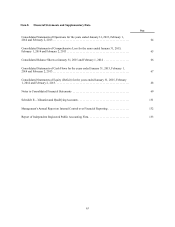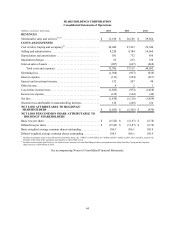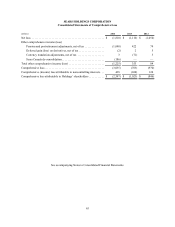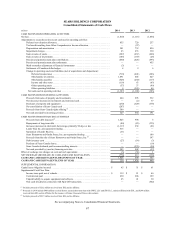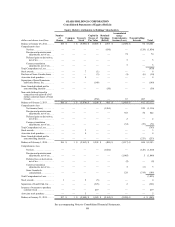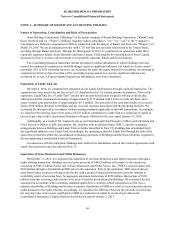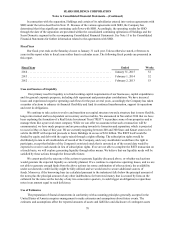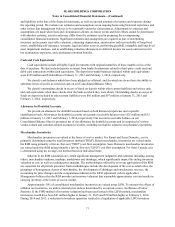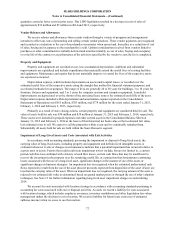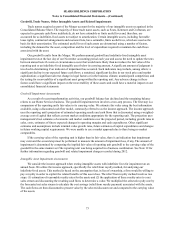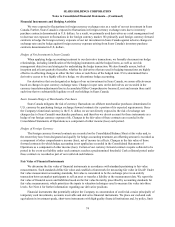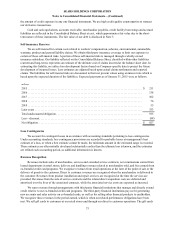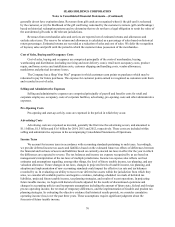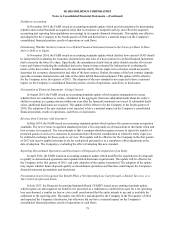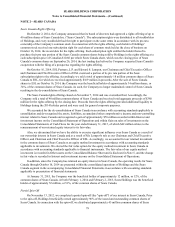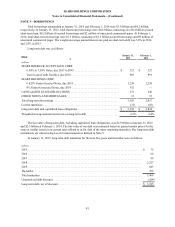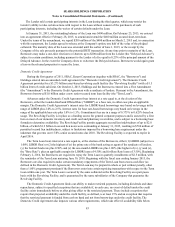Sears 2014 Annual Report Download - page 73
Download and view the complete annual report
Please find page 73 of the 2014 Sears annual report below. You can navigate through the pages in the report by either clicking on the pages listed below, or by using the keyword search tool below to find specific information within the annual report.SEARS HOLDINGS CORPORATION
Notes to Consolidated Financial Statements—(Continued)
73
Goodwill, Trade Names, Other Intangible Assets and Related Impairments
Trade names acquired as part of the Merger account for the majority of our intangible assets recognized in the
Consolidated Balance Sheet. The majority of these trade name assets, such as Sears, Kenmore and Craftsman, are
expected to generate cash flows indefinitely, do not have estimable or finite useful lives and, therefore, are
accounted for as indefinite-lived assets not subject to amortization. Certain intangible assets, including favorable
lease rights, contractual arrangements and customer lists, have estimable, finite useful lives, which are used as the
basis for their amortization. The estimated useful lives of such assets are determined using a number of factors,
including the demand for the asset, competition and the level of expenditure required to maintain the cash flows
associated with the asset.
Our goodwill results from the Merger. We perform annual goodwill and indefinite-lived intangible asset
impairment tests at the last day of our November accounting period each year and assess the need to update the tests
between annual tests if events or circumstances occur that would more likely than not reduce the fair value of the
reporting unit or an indefinite-lived intangible asset below its carrying amount. A significant amount of judgment is
involved in determining if an indicator of impairment has occurred. Such indicators may include, among others: a
significant decline in our expected future cash flows; a sustained, significant decline in our stock price and market
capitalization; a significant adverse change in legal factors or in the business climate; unanticipated competition; and
the testing for recoverability of a significant asset group within the reporting unit. Any adverse change in these
factors could have a significant impact on the recoverability of these assets and could have a material impact on our
consolidated financial statements.
Goodwill Impairment Assessments
As a result of recent transformation activities, our goodwill balance has declined and the remaining balance
relates to our Home Services business. The goodwill impairment test involves a two-step process. The first step is a
comparison of the reporting unit's fair value to its carrying value. We estimate fair value using the best information
available, using a discounted cash flow model, commonly referred to as the income approach. The income approach
uses the reporting unit's projection of estimated operating results and cash flows that is discounted using a weighted-
average cost of capital that reflects current market conditions appropriate for the reporting unit. The projection uses
management's best estimates of economic and market conditions over the projected period, including growth rates in
sales, costs, estimates of future expected changes in operating margins and cash expenditures. Other significant
estimates and assumptions include terminal value growth rates, future estimates of capital expenditures and changes
in future working capital requirements. We were unable to use a market approach due to there being no market
comparables.
If the carrying value of the reporting unit is higher than its fair value, there is an indication that impairment
may exist and the second step must be performed to measure the amount of impairment loss, if any. The amount of
impairment is determined by comparing the implied fair value of reporting unit goodwill to the carrying value of the
goodwill in the same manner as if the reporting unit was being acquired in a business combination. See Note 12 for
further information regarding goodwill and related impairment charges recorded during 2012.
Intangible Asset Impairment Assessments
We consider the income approach when testing intangible assets with indefinite lives for impairment on an
annual basis. We utilize the income approach, specifically the relief from royalty method, for analyzing our
indefinite-lived assets. This method is based on the assumption that, in lieu of ownership, a firm would be willing to
pay a royalty in order to exploit the related benefits of this asset class. The relief from royalty method involves two
steps: (1) estimation of reasonable royalty rates for the assets and (2) the application of these royalty rates to a net
sales stream and discounting the resulting cash flows to determine a value. We multiplied the selected royalty rate by
the forecasted net sales stream to calculate the cost savings (relief from royalty payment) associated with the assets.
The cash flows are then discounted to present value by the selected discount rate and compared to the carrying value
of the assets.


